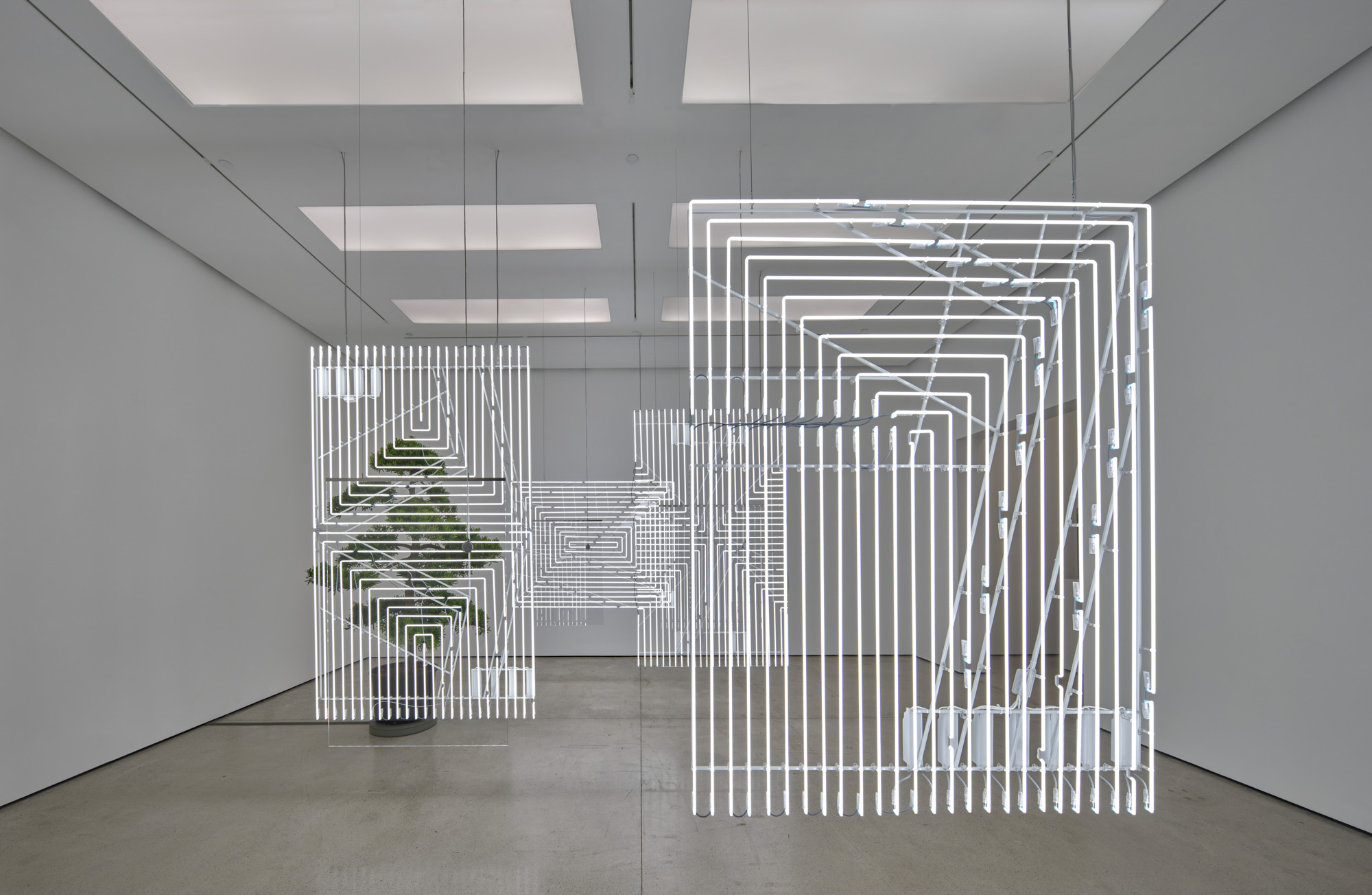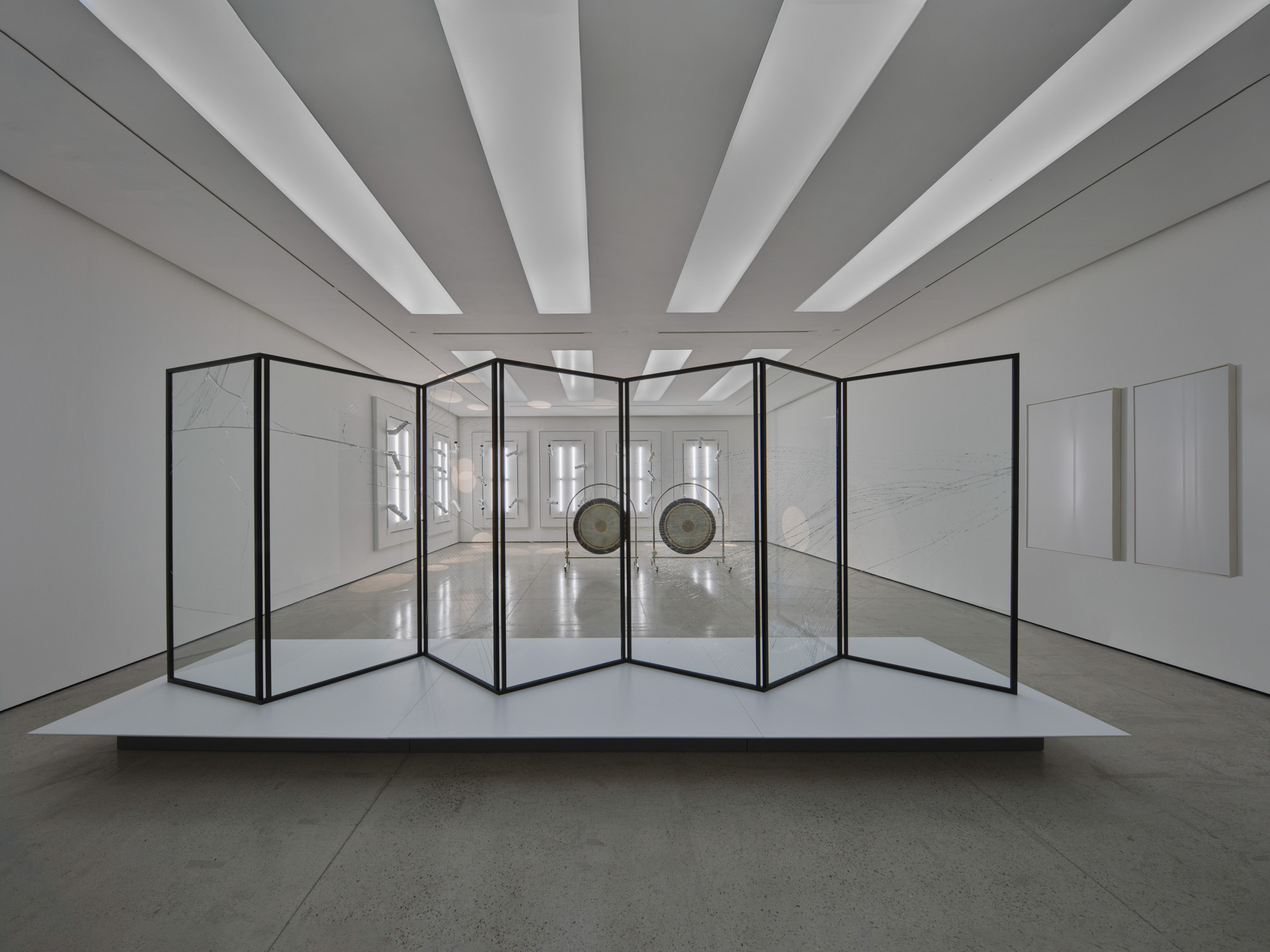Shows
Cerith Wyn Evans’s “. . . .)( of, a clearing”
(%20of%20a%20clearing%20White%20Cube%20Hong%20Kong%2021%20January%20%2012%20March%202022%20(medium%20res)%204.jpg)
(%20of%20a%20clearing%20White%20Cube%20Hong%20Kong%2021%20January%20%2012%20March%202022%20(medium%20res)%204.jpg)
Is it possible to exoticize modernism? In Cerith Wyn Evans’s exhibition “….)( of, a clearing” at White Cube in Hong Kong, the artist appropriates visual and conceptual tropes from iconic 20th-century artworks, rendering them in highly aestheticized installations that replace modernism’s defiantly raw materiality with the highly refined, consumerist materials of contemporary urban life. In the After Stella (2022) installation series, for instance, on the gallery’s ground floor, Evans takes the unpainted lines from Frank Stella’s series of Black Paintings (1958–60) and transforms them into panels of white-neon tubes, which are hung from the ceiling. Adjacent to these light-emitting panels are several suspended glass panes, attached to which are small directional speakers that play faint, tinkling piano notes or other barely audible sounds. Collectively, these elements frame Still Life (In course of arrangement. . .) VIII (2022), a potted ornamental pine tree that rests on an imperceptibly rotating turntable. When viewed together, the neon panels overlap to create the op-art-like moiré effect, as the sound emitted by the speakers blends into an evanescent ambience while the potted tree lends the space the air of Zen-inspired interior design, creating a curious mixture of associations with spaces of consumerism and more contemplative settings like a temple.
(%20of%20a%20clearing%20White%20Cube%20Hong%20Kong%2021%20January%20%2012%20March%202022%20(medium%20res).jpg)
The high-end retail aesthetic of Evans’s artworks, with undercurrents of “minimal” or “Asian” design, is deliberate and carefully tempered by associations with iconic modern art as well as conceptual and institutional critique strategies. On the gallery’s first floor, Evans displayed Folds. . .in shade (also light and shade) 7 leaves (2020), a large multi-sectioned byobu (Japanese folding screen) with glass panels that are delicately cracked, perhaps by a high-pitched sound, suggesting the presence of an inaudible pitch. These fractures in the glass evoke mountain-like forms like those in an ink painting, while also summoning to mind Marcel Duchamp’s iconic work The Bride Stripped Bare by Her Bachelors, Even (The Large Glass) (1915–23). Folds. . .in shade sits on a plinth in front of which are a pair of brass gongs that are played at regular intervals, filling the gallery with a deeper, more resonate sound than what might have created the fractures of Folds. . .in shade. The vibrations of sound in this gallery, echoed—and/or mirrored—the visual vibrations caused by the vertical bars of light downstairs.
Evans’s homage to institutional critique strategies—particularly the architectural appropriation of Michael Asher—was evident in a series of six panels, titled Light Track Assemblage (2022), that combine vertical pairs of LED-light tubes (recalling Dan Flavin’s fluorescent-tube compositions) and track-light systems modeled on those used at White Cube Bermondsey in London. Creating overlapping circles of yellow light on the wall and floor, the spotlights collapse the distinction between the artwork and the equipment of art’s display. Similarly toying with ideas of perception, along with the modernist history of monochrome painting—whether Kazimir Malevich’s, Robert Rauschenberg’s, Agnes Martin’s, or Lucio Fontana’s—are a nearby pair of white canvases from the Indeterminate Paintings series (2015– ) whose surfaces bear nearly invisible, Barnett Newman-like vertical “zips” of clear varnish.
.jpg)
Referring to philosopher Gilles Deleuze’s concept of the “plane of immanence” to describe a non-transcendent, non-dualistic world that doesn’t divide substance from forms, Evans applies a similarly contemporary approach to modern art itself, seeking to smooth the recurring dichotomy of pure Euclidian abstract forms and raw materiality into a refined, polyphonic sensorial experience. Rejecting the dualistic encounter of subject and object that runs through modern art, Evans proposes in his works that “[t]he perceiving subject is stripped of its flesh to reveal a hallucinating automaton, which promptly takes leave of the space of representation and its mimetic and perspectival ‘point of view,” so that “conditions of the pictorial, as such, might [artist’s emphasis] be rethought in the light of the visual.” Ultimately, for the artist, his work is intended as a path of liberation, an encouragement to experience things before us in a multisensory, nonhierarchical manner.
Cerith Wyn Evans’s “. . . .)( of, a clearing” is on view at White Cube Hong Kong until March 26, 2022.
HG Masters is ArtAsiaPacific’s deputy editor and deputy publisher.







